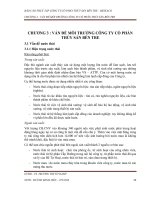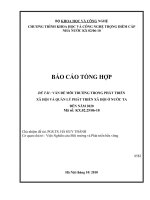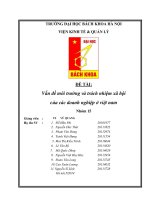vấn đề môi trường tại các hộ chế biến ốc vàng ở huyện phụng hiệp tỉnh hậu giang
Bạn đang xem bản rút gọn của tài liệu. Xem và tải ngay bản đầy đủ của tài liệu tại đây (539.95 KB, 10 trang )
<span class="text_page_counter">Trang 1</span><div class="page_container" data-page="1">
<b>Environmental Problems at The Yellow Snail Processing Households in Phung Hiep District, Hau Giang Province, Vietnam </b>
<i><b>Nguyen Thanh Giao<small>1</small>, Truong Hoang Dan<small>1</small> and Vuong Thi Giau Em<small>1</small></b></i>
<small>1College of Environment and Natural Resources, Can Tho University, Can Tho 900000, Vietnam Corresponding Author Email: </small>
<i><small>Received 27 February 2021 Revised 20 March 2021 Accepted 22 March 2021 Available online 04 June 2021 </small></i>
<i><small>The study was carried out to identify environmental problems related to the yellow snail processing households in Phung Hiep district, Hau Giang province, Vietnam, by interview and field sites survey. The study results showed that ten factories processing yellow snails </small></i>
<i><small>Over 80% of households did not have appropriate methods to treat by-products and wastewater, resulting in the deterioration of surrounding environmental media and potential adverse effects on human health. The yellow snail production households need to make environmental protection plans in accordance with the current environmental law to ensure that the production activities will not harm the environments. Future study should be implemented to quantitatively evaluate quality of soil, water and air in yellow snail processing area. </small></i>
<b>1. Introduction </b>
Vietnam is a country with rich and diverse genetic resources - species composition and ecosystems but it is less sustainable due to changes in environmental factors and the invasiveness of alien species such as the yellow snail, red-eared turtle, red crayfish, and mimosa, directly affects biodiversity, economic sectors, especially agriculture - forestry – fishery [1-2]. The presence of the yellow snail is one of the main causes leading to loss of productivity, increasing production costs, affecting product quality, the ecological environment, which leads to socio-economic impacts on agricultural production is not only in Vietnam but also in several tropical, subtropical and temperate countries in the world [3]. In paddy rice alone, in 2001, the southern provinces had 99,141 ha infected with yellow snails [4]. In Vietnam since 1994, decisions and directives on the prohibition of raising and eliminating yellow snails have been issued. Currently, the yellow snail has been included in the list of invasive alien species in Vietnam and the list of “100 most dangerous invasive alien species in the world” [2]. On the other hand, the yellow snail's meat contains a lot of protein, so the yellow snail is used as a food source for humans and livestock [5]. Yellow snails become attractive and sold at high prices, so many yellow snail processing households have been formed. The processing
</div><span class="text_page_counter">Trang 2</span><div class="page_container" data-page="2">income, create jobs for people, and contribute to the locality's socio-economic development [6]. The study was conducted to assess pollution sources and the environmental impacts in the yellow snail processing area. The current study results provide beneficial information for rural environmental management.
<b>2. Methodology </b>
The qualitative and quantitative information on current production status, sources of pollutants, impacts, and understanding of the yellow snail processing households in the study areas was collected by investigating and directly interviewing the yellow snail processing households and workers the three communes (Hiep Hung, Tan Phuoc Hung, and Bung Tau towns) Phung Hiep district, Hau Giang province, from September to December 2020 with a designed questionnaire. The contents of the questionnaires comprised of the personal information of the households (full name, gender, address, experiences in yellow snail processing), yellow snail production processes including inputs and outputs, treatments of the wastes generated in the production areas. This study also aimed to estimate the number of wastewaters, solid wastes generated in the production model.
<b>3. Results and discussion </b>
3.1 Assessment and prediction of the impacts of waste generation sources
The results of field surveys and interviews with households related to the processing of yellow snails have identified three primary pollution sources, including emission, domestic and industrial wastewater, domestic and industrial solid waste.
3.1.1 Air pollution
Particulate matters and gaseous emissions of the transportation activities were mainly emitted from motorbikes. Purchasing raw material (yellow snails) occurs within a radius of 10 km. It was estimated that the purchase was done three times back and forth using motorbikes. Previous study found that the motorcycle consumes 0.03 litter of gasoline per kilometer. The emission factors for SO<small>2</small>, NO<small>x</small>, and CO per one ton of gasoline are 20 x (0.1%), 8 and 525 kg/ton gasoline, respectively. The loading factors of emission gasses of SO<small>2</small>, NO<small>x</small>, and CO are 0.003, 1.21, and 79.38 kg,
<b>respectively [7]. The calculated concentrations of the emitted gasses from the transportation in the </b>
yellow snail for each household is showed in Table 1. The results indicated that the concentrations of generated SO<small>2</small>, NO<small>x</small>, and CO emissions were 2800, 4, and 9 times lower than those regulated in QCVN 05: 2013/BTNMT (Table 1). Besides, this is a non-point pollution source, so it does not greatly impact the surrounding environment and people living in the study area.
<b>Table 1: The concentration of emissions from transportation activities </b>
<b>Motorbike </b>
<b>QCVN 05: 2013/BTNMT* (mg/m<small>3</small>) </b>
1 Particulate matters
</div><span class="text_page_counter">Trang 3</span><div class="page_container" data-page="3"><i>*QCVN 05:2013/BTNMT – National technical regulation on ambient air quality </i>
Emissions generated from yellow snail production activities were mainly from solid organic matter and sulfur-based organic substances (H<small>2</small>S, NH<small>3</small>) [8]. The anaerobic decomposition of these matter has resulted in the formation of odorous compounds such as methyl mercaptan (CH<small>3</small>SH) and aminobutyric acid (CH<small>3</small>CH<small>2</small>CH<small>2</small>(NH<small>2</small>)COOH). Methyl mercaptan can be biochemically hydrolyzed to methyl alcohol and H<small>2</small>S, forming foul odors, growing bacteria and insects. It can cause respiratory and dermatological diseases for the community. The results of survey showed that 9 out of 20 households living near yellow snail processing facilities often smell unpleasant odors coming from the processing facilities (45%); 6 out of 20 households sometimes smell bad odors (30%) and only 5 households did not feel bad smells (25%) because they have adapted to the conditions for a long time. However, frequent exposure to H<small>2</small>S at concentrations below acute toxicity levels can cause chronic toxicity with manifestations such as depression, nervous system disorders, menstruation, digestive system, mood swings, difficulty concentration, insomnia, chronic bronchitis.
<b>Figure 2. The dumping of by-products from yellow snail processing </b>
In addition, during the processing of yellow snail, a large amount of heat for boiling the snail has been also used. Thus, a large amount of fuel has been applied, mainly coal and firewood, which emits certain amount of CO, CO<small>2</small>, SO<small>2,</small> and NO<small>2 </small>into the air.
3.1.2 Water pollution
The source of impact on the water environment from the operation of yellow snail processing facilities is mainly production wastewater and domestic wastewater. The amount of wastewater generated from workers' activities in the yellow snail processing facilities with 60 workers at ten facilities about 6-8 hours/day. Other activities are taking place at home, so the amount of water used is only half of the water supply rating. Therefore, it is estimated that the amount of domestic wastewater is 3.6 m<small>3</small>/day. Domestic wastewater from yellow snail processing facilities was directly discharged to Cai Con canal and this could cause serious water pollution once the production activities are extended.
According to the yellow snail processing process, wastewater is mostly generated from washing and boiling the yellow snail as well as the cleaning of the facility, production tools and equipment. These processes consumed a large amount of water. Most of the water sources used for production are from river water (70%), groundwater (30%) (Figure 3). According to the survey results, each facility produces an average amount of 89.4 kg of yellow snail meat/day. To make 1 kg of the final product, 2.5 liters of water is needed. With an output of 894 kg/day, the water demand for daily
</div><span class="text_page_counter">Trang 4</span><div class="page_container" data-page="4">generated is equal to the amount of supply water. The wastewater contains high amount of suspended solids and biodegradable organic matters. However, it was discharged directly into the environment (80% of the households discharge directly to the canals, 20% of the households discharge directly to the ground) beyond the self-cleaning capacity of the Cai Con and Quan Lo canals, affecting water quality and losing the aesthetics. In particular, the presence of NH<small>3 </small>with high concentrations in the water environment can be toxic to fish and aquatic organisms. The excess phosphorus and nitrogen in yellow snail generating wastewater discharged into the river would potentially cause eutrophication. Also, suspended solids increase turbidity, which significantly affects primary productivity of water ecosystem. Most yellow snail processing facilities in Phung Hiep district do not have appropriate measures to collect and treat the wastewater because of inadequate economic conditions.
<b>Figure 3. Yellow snail processing wastewater </b>
3.1.3 Impacts of solid wastes
<i>a) Solid wastes from yellow snail processing </i>
Solid wastes from yellow snail processing is mainly the by-products from the production process, such as shells and useless parts of the snail. Moreover, the packaging process also generates solid wastes which are often the damaged packaging.
<b>Table 2: Demand for raw materials and products of yellow snail processing facilities </b>
Raw material demand (kg/day)
Product (Yellow snail meat)
(kg/day)
Solid wastes generated
(kg/day) Yellow snail processing
facilities (10 households)
The number of solid wastes from yellow snail processing households was presented in Table 2. With the raw materials of 3,320 kg per day, the expected solid wastes generation is 2,426 kg per day. The example of solid wastes generated from the production process is showed in Figure 4.
</div><span class="text_page_counter">Trang 5</span><div class="page_container" data-page="5"><b>Figure 4. Solid wastes generated from yellow snail processing </b>
Through investigations of 10 yellow snail processing households, it was found that these production households operate all year round, and the peak time of the production is from August to November on the yearly basis. During the flooding season (August-November), the population of yellow snail increase rapidly leading to the busiest time of yellow snail processing activity. Regarding the methods of treatment of solid wastes generated from the yellow snail processing (Figure 5), it was found that 10% of the households treated the solid wastes by collecting and dumping it in the garbage trucks; 10% of the households treated the wastes by dumping it in bare land; 20% of the household treated the snail shells by placing it on the bare ground, drying and burning. The remaining households (60%) treated the solid wastes of yellow snail shells by discharging it directly into the river. Currently, there are garbage trucks to collect the production wastes together with the domestic wastes. However, small proportion of the households handle the wastes to the collector because the fee is required for production waste collection (4,000 - 5,000 VND per sack of snail shell).
<b>Figure 5. Disposal of solid waste in the snail processing facility </b>
Production solid waste that is not collected and treated properly would cause unsanitary conditions in the area of the yellow snail processing households. This type of waste would attract
<small>Discharge to river</small>
<small>Discharge to land with treatment</small>
<small>Handling to the collector</small>
<small>Discharge to land without treatment</small>
</div><span class="text_page_counter">Trang 6</span><div class="page_container" data-page="6">wastes were stored for too long (more than one day), the by-products would be decomposed by microorganisms to produce odous gases. It has resulted in unpleasant odors for employees working at the facility and households living near the facility which could lower the quality of life.
b) Domestic wastes
Domestic wastes at the household are generated from the daily-life activities of 60 workers and managers at 10 yellow snail processing facilities in Phung Hiep district. However, the workers only work at the facilities for about 8 hours/day, so it is estimated that the amount of generated solid waste is about 0.5 kg/person/day. Therefore, the amount of domestic waste generated is 30 kg/day. Household waste is mainly biodegradable organic substances that will cause bad odors and adverse effects on environmental hygiene, aesthetics, and human health. Long-term accumulation would contaminate the soil and water environment in the waste storage area.
3.1.4 Impacts on human health
Most of the workers in the yellow snail processing facilities in the district are female (85%), a few men (15%) are in and above the working-age. Most of the workers are local people and have been working for 2 - 10 years. They agreed that this work is easy. However, it brings some effects to the workers' health. The survey results showed that 80% of workers suffer from health problems, including 48% of hand water, 28% of back pain, and 3.2% allergic to water. Due to their continuous working process, contact with water, work in wet environments, wear gloves, covered gloves, and high intensity and posture are inappropriate. In addition, in the production process, workers are often exposed to hazards such as H<small>2</small>S, NH<small>3 </small>arising from the decomposition of organic matter, which will cause serious health effects [8]. NH<small>3 </small>and H<small>2</small>S are toxic gases that can cause death when exposed at high concentrations (NH<small>3</small>: 1500 to 2000 mg/m<sup>3</sup>; H<small>2</small>S 700 to 900 mg/m<sup>3</sup>). Regular exposure to these hazards and prolonged exposure affects the mind, health, and concentration during the working process. Workers could potentially expose to harmful microbes in such working conditions. Results of survey of 20 households near the yellow snail production area showed that 45% of households rated the level of serious impact causing discomfort to family health because people often smell bad odors. In many cases the follow-up reactions of the frequently exposed to the unpleasant smell should be carefully considered. For example, strong odorous gases could result in vomiting. On the other hand, the bad smell persists and often makes people lose sleep, stimulating nerves effects. 3.1.5 Changes in landscape and biodiversity
The operation of yellow snail processing households, the local landscape and the environment may have been subjected to changes. The by-products were found dumping in the canals and bare land (Figure 6) that could cause physical, chemical and biological damage of the environment and loss the beauty nature of the rural area.
</div><span class="text_page_counter">Trang 7</span><div class="page_container" data-page="7"><b>Figure 6. By-products and wastewater in the snail processing facilities </b>
The pollution problems caused by yellow snail processing perceived by the local people are presented in Figure 7. The results of the interviews showed that 20 households living around these processing facilities agreed that the yellow snail processing would cause environmental problems which wastewater, solid wastes and emission gases contributed by 25, 50 and 35%, respectively. Water, soil and air are seriously influenced by the wastes generated from the production.
<b>Figure 7. Pollution caused by the yellow snail processing </b>
3.2 Potential effects of yellow snail processing 3.2.1 Potential impact on the natural environment
Storing industrial and domestic wastes has resulted in the formation of a foul smell such as H<small>2</small>S, CH<small>4</small>, CO<small>2</small>. This directly affects to owners of the processing facilities and workers working here every day. Moreover, the transport of these toxic gases impacts households living near this area. However, the problem is only local at the facility and the surrounding environment, so it has low impact and can be mitigated. The impact from the high decomposition of organic matter in the
<small>(1) Water pollution due to wastewater(2) Water pollution due to by-products(3) Soil pollution due to wastewater(4) Pollution due to domestic wastes(5) Air pollution</small>
<small>Medium influenceNo influence</small>
<small>Serious influenceHighly serious influence</small>
</div><span class="text_page_counter">Trang 8</span><div class="page_container" data-page="8">canal will be affected indirectly, aquatic organisms living in water sources is also affected. This impact will last throughout the operation of the establishment. The level of impact is high, but this source of influence is likely to be controlled. The soil environment is not affected seriously by the production activities of these processing facilities and the localized situation at waste storage sites. The low impact level due to this pollution source is likely to be tightly controlled by applying the mitigation measures outlined in the following section.
3.2.2 Potential impact on human health
Trading and processing yellow snails have brought a significant source of income to the producers and local people. The wastes from the operations of yellow snail processing facilities have been polluting the environment, reducing the quality of life and directly affecting the health of the working people and the district area. Direct impact on the family of the household owners - workers working in the establishment and indirectly impact on people living near the production area. However, this problem can be mitigated through the use of protective equipment.
<b>3.3 Proposed solutions for processing wastes generated from yellow snail processing </b>
<i>3.3.1 Production and domestic solid wastes </i>
Domestic solid wastes would be collected in the distinct solid waste bins. The biodegradable solid wastes could be placed in the field or in the garden as organic fertilizer. The reusable wastes such as plastic bottles, carton, and plastic packages should be collected, stored and then sold to the vendors. For the solid wastes from yellow snail processing, all the produced wastes should be collected and properly stored. The solid waste owners should contract with the legalized partners to collect and treat the wastes. For the far future, the yellow snail solid wastes could be utilized to get the power products as indicated in Figure 8. The powder products may contain large amount of useful chemical constituents which could be used in other processes. Yellow snail shell can be used as fertilizer and animal feed. Yellow snail shells are collected from yellow snail processing facilities in the district. After collecting, the shells are washed, then dried. The shell is then ground into powder. The yellow snail shell is rich in Ca (30%) and nitrogen (15%) and phosphorus (0.01%) [5]. Mixture of the yellow snail powder with animal feed could provide calcium to the animals. Besides, yellow snail shell powder can also be used as fertilizer for improving soil acidity, and pH.
<b>Figure 8. Proposed method for yellow snail shell treatment </b>
3.3.2 Domestic and production wastewater
The domestic wastewater generated from washing, bathing, and toileting should be collected. In addition, wastewater from the yellow snail processing should also be collected as indicated in Figure 9. The collected wastewater would be treated using decentralized wastewater treatment systems proposed in Figure 10. All wastewater generated by the household follows the collection pipes to flow to the main water collection pipe Wastewater is allowed to flow through the barriers to remove large debris. Then, wastewater will be pumped to sand settling tank to remove sand, gravel, crushed stone and other substances that need to be treated to ensure efficiency in the biological treatment process in the next stage. After passing the settling tank, the wastewater will
</div><span class="text_page_counter">Trang 9</span><div class="page_container" data-page="9">be pumped into the sequential batch reactor (SBR), a biological tank. In the SBR tank, there are five stages: (1) the tank is filled with wastewater, at which time the aerator can be turned on or off; (2) when the tank is full of water, the wastewater is ventilated and stirred, a biodegradation reaction will occur; (3) next is to stop aeration to allow suspended solids to settle; (4) After the sludge has settled, the surface water layer will be discharged from the tank and then some sludge will also be discharged from the tank; (5) start the new cycle of the wastewater treatment. These phases are performed continuously in 1 tank and alternating in 2 tanks with the cycle of operation of SBR tank. The treated wastewater will be passed through the disinfection tank, chlorine is filled into the sterilization tank according to the determined dosage. The wastewater after passing through the disinfection tank readily meet the discharge standard. For the sludge, it is pumped from the SBR tank after each batch of the treatment to the sludge tank, a part of the sludge will be circulated to the SBR biological tank to increase the density of bacteria to speed up treatment process. The excess sludge will be sent to the sludge treatment system.
<b>Figure 9. Demonstration of wastewater collection system</b>
<b>Figure 10. Proposed decentralized wastewater treatment for yellow snail processing </b>
3.3.3 Solutions based on legal document
Following the guidance of the Government's Decree No. 38/2015/ND-CP dated April 24, 2015 on waste and scrap management encourages the application of bio-products and environmentally
</div><span class="text_page_counter">Trang 10</span><div class="page_container" data-page="10">rural industries. There is urgent need to plan and construct concentrated production zones/clusters in which the technical infrastructure for environmental protection has been completed. The local government should enhance their decisive role in environmental protection, for examples, environmental law enforcement, implementation, propagation, and inspection. In the community, the local authorities need to strengthen the inspection and remind the operations of the facilities to implement the management solutions effectively to protect surrounding environment. The monitoring programs of water, soil and air should be periodically conducted to detect potential environmental problems and to rapidly respond to the emergent situation. Producers should be educated that they should pay the fees for environmental protection thus enhancing public awareness of environmental protection.
<b>3. Conclusions </b>
The results of yellow snail processing facilities in Phung Hiep district, Hau Giang province showed that the waste components are mostly by-products and wastewater generated from the production process. Ten factories processing yellow snails discharged 2235 m<small>3</small> of wastewater and 2426 kg of by-products per day. More than 80% of households did not have appropriate methods to treat by-products and wastewater, resulting in the deterioration of surrounding environmental media and potential adverse effects on human health. Actions should be taken to mitigate the environmental problems at the yellow snail processing households, for example, completing the wastewater and solid wastes treatment system.
<b>References </b>
<i>[1] Du Quang Tuan, 2001. Distribution, spread and harm of yellow snail, Pomacea canaliculata </i>
(Ampuliarridae, Mesogastropada), and some control measures in some provinces in the Mekong Delta. Master thesis. Can Tho University.
[2] Vietnam Environment Administration, 2011. Handbook to introduce some invasive alien species in Vietnam. Hanoi, 62 pages.
[3] Plant Protection Department, 2000. Yellow snails and prevention measures. Agricultural publisher. Hanoi, 88 pages.
[4] Nguyen Huu Huan and R.C Joshi, 2002. Golden apple snail situation and integrated management activities in South Viet Nam. Paper presented at The Seventh International Congress on Medical and Applied Malacology (7<sup>th</sup> ICMAM), Los Banos, Laguna, SEAMEO Regional Center for Graduate Study and Research in Agriculture (SEARCA). Philippines, 6 pages.
<i>[5] Serra, A.B. 1997. The use of Golden Snail (Pomacea sp.) as animal feed in the Philippines. </i>
</div>








